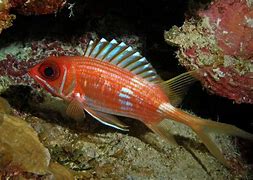
Squirrelfish
Squirrelfish is the common name for a group of fish species belonging to the family Holocentridae. They are primarily found in tropical and subtropical waters, particularly in the Atlantic, Indian, and Pacific Oceans. Here are some interesting facts about squirrelfish:
Appearance: Squirrelfish have a distinctive appearance with a deep and laterally compressed body. They typically have large eyes and a large mouth with sharp teeth. The coloration of squirrelfish varies among species but often includes shades of red, orange, yellow, or brown. Many species have a pattern of vertical stripes or bars on their bodies.
Nocturnal Behavior: Squirrelfish are primarily nocturnal, spending their days hiding in crevices or among coral or rocky formations. As night falls, they become more active and venture out to hunt for prey. Their large eyes are well-adapted for low-light conditions, allowing them to navigate and locate food in the dark.
Habitat: Squirrelfish are commonly found in coral reefs, rocky areas, and shallow coastal waters with plenty of hiding places. They prefer areas with caves, crevices, or overhangs where they can take shelter during the day. Some species may also inhabit deeper waters.
Feeding Habits: Squirrelfish are carnivorous predators, feeding on a variety of small invertebrates and small fish. Their diet includes crustaceans, worms, small mollusks, and zooplankton. They use their sharp teeth to seize and devour their prey.
Venomous Spines: Squirrelfish have spines on their dorsal fins, which are venomous and can inflict painful wounds if handled or stepped on. These spines serve as a defense mechanism against predators and are used to deter potential threats.
Schooling Behavior: Some species of squirrelfish are known to form large schools, particularly during their reproductive periods. Schooling provides protection from predators, increases foraging efficiency, and enhances their chances of successful reproduction.
Reproduction: Squirrelfish exhibit various reproductive strategies depending on the species. Some species are oviparous, meaning they lay eggs that hatch externally. Others are viviparous, giving birth to live young. In some cases, males guard the eggs until they hatch.
Relationship with Cleaner Fish: Squirrelfish, like many reef fish, often form symbiotic relationships with cleaner fish. Cleaner fish, such as cleaner wrasses, remove parasites and dead skin from the squirrelfish, benefiting both species. This cleaning behavior helps maintain the health of the squirrelfish and may even reduce the risk of infection.
Conservation Status: The conservation status of squirrelfish species varies depending on the region and specific species. Some populations may face threats from habitat degradation, overfishing, and the impacts of climate change. Proper management and protection of their habitats are essential for their conservation.
Aquarium Trade: Some species of squirrelfish are popular in the aquarium trade due to their vibrant colors and interesting behavior. However, they require specific tank conditions, including appropriate hiding places, suitable tank mates, and a well-maintained marine environment to thrive in captivity.